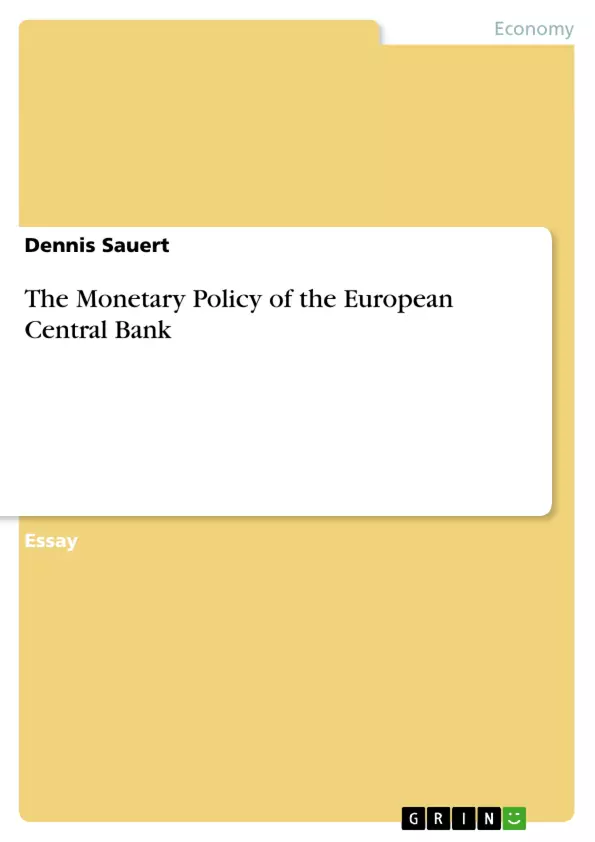The national currency of each country in Europe was an indispensable element of national sovereignty and bank notes as an expression of national culture and trademark. With successive significance of bank notes as a means of payment in modern economic life central banks gradually gained a stronger role and
monetary policy has become an integrated part of economic policy.
In respect to this development the implementation of stage three of the EMU in 1999 was an important caesura in European history since a major part of European political independent countries gave up their sovereignty of monetary policy by adopting and agreeing on an irrevocable peg of their domestic currency to the Euro. This required a change to a new European monetary policy in the sector of European central banking. Thus, the ECB was
founded and the NCB’s of the MS integrated into a European central bank system. It has never been achieved a similar integration process of a policy area in the EU as that of the common monetary and exchange rate policy. The EU has nowhere else been more authentically developed in its identity than in the area
of the Euro and the ECB. Nowadays, the participating MS form a currency area that is considered as the second largest economic area behind the USA. This reveals the worldwide significance of European monetary policy that will be explained in the following. The first chapter will briefly comment on the institutional framework structure before the topic of price stability will be introduced. Chapter four and five will examine the transmission process and the monetary strategy of the ECB. In the sixth chapter monetary instruments will be closely described while chapter seven explains the use of instruments of the ECB to
react to the current financial crisis. Concluding, a short assessment of European monetary policy will then frame the end of this paper.
Inhaltsverzeichnis (Table of Contents)
- The Development of the Euro
- The Institutional Framework
- Tasks of the ECB
- Price Stability
- Transmission Mechanism
- Interest Rate Variable
- Foreign Exchange Rate Variable
- Asset Prices Variable
- Loan Variable
- Quantity Theory of Money
- The 2 Pillars Strategy
- Economic Analysis
- Monetary Analysis
- The Operational Framework
- Open Market Operations
- Main refinancing operations
- Longer term refinancing operations
- Fine tuning operations
- Structural operations
- Standing Facilities
- Marginal lending and deposit facility
- Minimum Reserve
- Open Market Operations
- How Does the ECB Respond to the Current Crisis?
Zielsetzung und Themenschwerpunkte (Objectives and Key Themes)
This paper analyzes the monetary policy of the European Central Bank (ECB) by outlining its development, institutional framework, and key objectives. It explores the transmission mechanisms through which the ECB influences economic activity and examines the strategies it employs to maintain price stability.
- Development of the Euro and the establishment of the ECB
- The ECB's institutional framework and its role in the European Monetary Union (EMU)
- The ECB's primary objective of maintaining price stability
- The transmission mechanisms of monetary policy, including interest rates, exchange rates, asset prices, and lending
- The ECB's monetary strategy, including its two-pillar approach and operational framework
Zusammenfassung der Kapitel (Chapter Summaries)
The paper begins by tracing the development of the Euro and its impact on European monetary policy. It highlights the significance of the ECB's creation and its role in integrating national central banks into a single European system. The paper then examines the institutional framework of the ECB, including its tasks and objectives, and elaborates on its primary mandate of maintaining price stability.
The paper proceeds to analyze the transmission mechanisms through which the ECB's monetary policy affects the economy, including interest rate adjustments, exchange rate movements, changes in asset prices, and lending activity. It also delves into the ECB's monetary strategy, particularly its "two-pillar" approach, which combines economic and monetary analysis to guide policy decisions. The paper further examines the operational framework of the ECB, including its use of open market operations, standing facilities, and reserve requirements.
Schlüsselwörter (Keywords)
The core concepts explored in this paper include European monetary policy, the European Central Bank (ECB), the Euro, price stability, transmission mechanisms, monetary strategy, two-pillar approach, open market operations, standing facilities, and reserve requirements. It also delves into the impact of the financial crisis on the ECB's monetary policy and its responses to this challenge.
- Quote paper
- Dennis Sauert (Author), 2009, The Monetary Policy of the European Central Bank, Munich, GRIN Verlag, https://www.grin.com/document/138915



